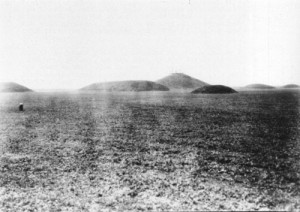Walmart and the Mound Builders
by Heather Pringle
July 3, 2009
 I once spent a truly magical week along the banks of the Scioto River in Ohio with an archaeologist who loved earthen mounds. We set out in the early morning light along dusty country roads, pulling over from time to time in a National Park Service truck to gaze into the distance at gently rolling grassy swells. These were remnants of the region’s great prehistoric earthworks —walls that dated back more than 1500 years and that once formed elaborate mazes of giant circles, squares and other geometric forms.
I once spent a truly magical week along the banks of the Scioto River in Ohio with an archaeologist who loved earthen mounds. We set out in the early morning light along dusty country roads, pulling over from time to time in a National Park Service truck to gaze into the distance at gently rolling grassy swells. These were remnants of the region’s great prehistoric earthworks —walls that dated back more than 1500 years and that once formed elaborate mazes of giant circles, squares and other geometric forms.
When the first Europeans arrived in America, they marveled at a mysterious landscape of immense mounds and earthworks that rose along many parts of the eastern woodlands. In their arrogance, they could scarcely believe that ancestors of the Native Americans had designed and constructed these huge earthen monuments. So they sat down with their bibles and scoured historical records for clues to the makers. Were the Mound Builders actually Phoenicians? Toltecs? Perhaps a lost tribe of Israel?
Scholars hotly debated the issue, and eventually the Smithsonian Institution established its own Division of Mound Exploration, hoping to crack the mystery. After years of meticulous study, Cyrus Thomas, head of the Division, announced in 1894 that “the links directly connecting the Indians and the mound-builders are so numerous and well established, that archaeologists are justified in accepting the theory that they are one and the same people.â€
Since then, I am sorry to say, the intense public interest in prehistoric mounds has largely dissipated. Indeed as archaeologists learn more and more about the rich variety of mound-building cultures, from the Poverty Point people to the Hopewell, fewer and fewer people take any notice. We seem, somehow, to have misplaced our sense of awe and wonder. And perhaps this is why politicians in Oxford, Alabama, recently gave a private contractor the right to level a major prehistoric mound for fill dirt for the foundation of a new big box store—Sam’s Club, owned by Walmart.
Local archaeologists and Native Americans are up in arms about this. As Jacksonville State University archaeologist Harry Holstein pointed out in one article, “There is substantial ethnographic and archaeological evidence from similar stone mound sites throughout the eastern United States that these stone mounds, walls and effigies atop mountains, ridges and plateaus were built to commemorate deceased loved ones and important events and bury sacred offerings.â€
But when the opponents voiced their deep concerns about the destruction of the mound, Oxford’s mayor and city project manager apparently shrugged them off. According to a report in a local paper, The Anniston Star, Mayor Leon Smith claimed the mound was used for little more than sending smoke signals. I find this a bizarre and belittling claim, one that flies in the face of scientific evidence on mound-building cultures and the ceremonial way in which they often raised these impressive earthen edifices.
I think that Oxford’s politicians have really sent us all the wrong signal here. What we need is far more respect for those who first walked this great continent of ours, not another Sam’s Club.
Just something to think about this 4th of July.
Comments posted here do not represent the views or policies of the Archaeological Institute of America.






 Heather Pringle is a freelance science journalist who has been writing about archaeology for more than 20 years. She is the author of Master Plan: Himmler's Scholars and the Holocaust and The Mummy Congress: Science, Obsession, and the Everlasting Dead. For more about Heather, see our
Heather Pringle is a freelance science journalist who has been writing about archaeology for more than 20 years. She is the author of Master Plan: Himmler's Scholars and the Holocaust and The Mummy Congress: Science, Obsession, and the Everlasting Dead. For more about Heather, see our 



